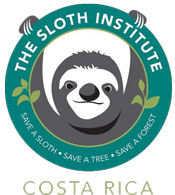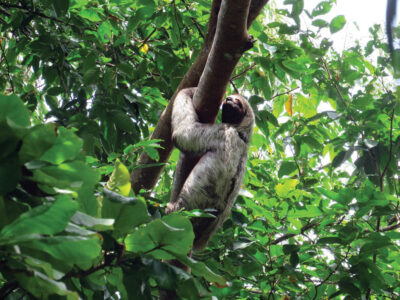MEET ELSA
 Sara Ferreiro, TSI Research Manager
Sara Ferreiro, TSI Research Manager
Elsa is a three-fingered sloth. She’s part of the Research Program that we developed in the Tulemar property.
Since 2016 (Resolution: ACOPAC-INV-002-16), The Sloth Institute has been studying sloths in their natural habitat. The main objective of our program was to study the behavioral ecology of recently released hand-raised sloths that were rescued as small orphans and compare them with the behavioral ecology of wild sloths. This post-release monitoring helped the well-being of each released individual as well as provided valuable information to analyze the effectiveness of sloth rehabilitation protocols. Furthermore, this acted as a pilot study on the best way to research the health and conservation of sloths in Manuel Antonio, with the future potential to compare their behavioral ecology with sloths in other areas of Costa Rica.
 Due to the success of our findings, we continued working not only in Tulemar (Resolution: ACOPAC-INV-001-17) but also expanded to the Sarapiquí area of Costa Rica (Resolution N° 014-2017-ACCVC-PI) to work with other Rescue Centers and help them learn how to release their sloths. That was our SAVING SLOTHS TOGETHER Program, run in collaboration with Toucan Rescue Ranch.
Due to the success of our findings, we continued working not only in Tulemar (Resolution: ACOPAC-INV-001-17) but also expanded to the Sarapiquí area of Costa Rica (Resolution N° 014-2017-ACCVC-PI) to work with other Rescue Centers and help them learn how to release their sloths. That was our SAVING SLOTHS TOGETHER Program, run in collaboration with Toucan Rescue Ranch.
Daily, we followed more than 20 sloths from both species (two fingered and three fingered) and with more than 6000 hours of observations, we learned about habitat preference, ranging patterns, population densities, diet, reproductive behavior, and lot more! In addition, when possible, we performed medical health checks on those individuals. What were the conclusions of our study? Well, our data supports the release of all groups of sloths: born in the wild, hand-raised, rehabilitated, pet trade and even individuals with some disability (missing a limb or eye) of both species found in Costa Rica. Basically ALL sloths deserve a second chance to be wild!
 So, who is Elsa? Elsa is an adult three-fingered sloth that lives in the Tulemar forest. Her life didn’t start off very easy. She suffered from a broken back which led to paralysis that affected both of her legs and her mom decided to abandon her when she was very little. However, thanks to our years of research and refined rehabilitation protocols, Elsa received all of the proper care that she needed and we were very pleased that she was able to recover most of her mobility. Based on previously studied disabled sloths, we knew that she had a good opportunity to live back in the wild. So she was released and has so far been thriving!
So, who is Elsa? Elsa is an adult three-fingered sloth that lives in the Tulemar forest. Her life didn’t start off very easy. She suffered from a broken back which led to paralysis that affected both of her legs and her mom decided to abandon her when she was very little. However, thanks to our years of research and refined rehabilitation protocols, Elsa received all of the proper care that she needed and we were very pleased that she was able to recover most of her mobility. Based on previously studied disabled sloths, we knew that she had a good opportunity to live back in the wild. So she was released and has so far been thriving!
Now, Elsa is part of a new research project that we are working on with our colleagues from the Sloth Conservation Foundation on the Caribbean side of Costa Rica (Resolution Nº R-SINAC-SE-DT-PI-025-2023). The goal of this study is to learn about the impacts of habitat disturbance and rainforest urbanization on the behavior of sloths in the wild. The aim is to compare the behavior of sloths living in urbanized areas (secondary forests) with protected primary rainforest. The results will be used to develop effective conservation strategies that will help humans and sloths peacefully coexist. By joining forces with our friends on the Caribbean coast, we can compare the behavioral ecology of urban sloths in two different regions of Costa Rica. The more information we gather and the more partnerships we develop, the more sloths we can help in Manuel Antonio and across Costa Rica!
If you want to know more about Elsa and other sloths, check our website theslothinstitute.org or follow us in our social media: facebook.com/theslothinstitute or instagram.com/theslothinstitute.
